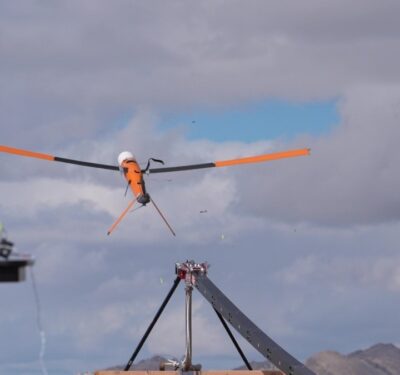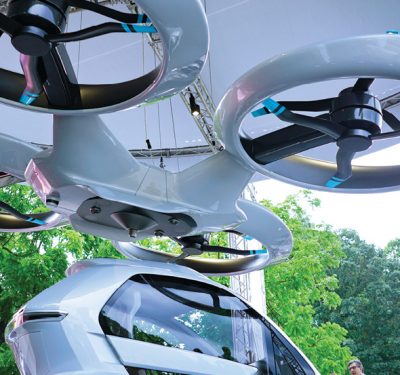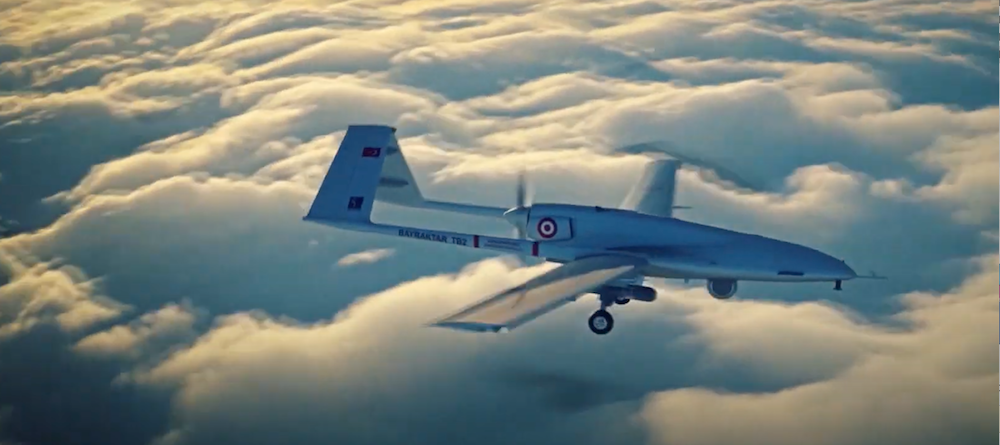
The Turkish TB2 combat drone has made a name for itself in Ukraine. Image courtesy of Baykar Bayraktar.
Russia’s invasion of Ukraine is full of lessons for the US. New ones like the lethality of modern anti-tank missiles and the importance of information warfare. Old ones reinforced, like the importance of morale in warfare. The lesson I hope my fellow airmen remember is another old one—the importance of airpower in situations short of warfare.
I am writing this in late March 2022, and I hope there is peace in Ukraine without involving allied airpower by the time this article is published. I do not have the space to debate if or when a coalition of the U.S. and its allies should establish a no-fly zone over Ukraine, but I will discuss how to implement a no-fly zone without risking coalition airmen by taking advantage of another lesson of Ukraine—the startling effectiveness of drone warfare. I will begin with what a coalition can do with today’s drones, and then discuss what they could do in another 5 years with autonomous drones.
No-fly with No Crews Today
Many Ukrainian heroes will emerge from Russia’s invasion, but the most unlikely will be the Turkish Baykar Bayraktar TB2 drone. About two-thirds the size of a General Atomics MQ-1 Predator, the TB2 was supposed to last for only a few days in the invasion. It has no defense systems, no SATCOM data link that allows pilots to fly it from thousands of miles away, and it is a conventional drone with absolutely no stealth features to reduce radar reflections. Russian air defenses should have shot down every TB2 air vehicle, and Russian artillery should have destroyed every ground control station within days. But they didn’t, and it seems that rumors of the death of the conventional drone are greatly exaggerated.
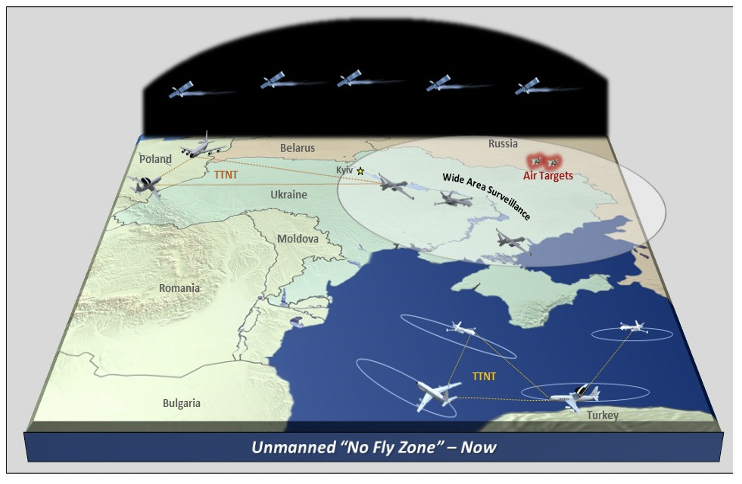
A coalition would have plenty of conventional drones available for a no-fly zone over Ukraine. Using readily available drones like the General Atomics MQ-9 Reaper combined with manned intelligence, surveillance and reconnaissance (ISR) aircraft such as the E-3/AWACS and RC-135/RIVET JOINT, the coalition could monitor all of Ukraine with both radar and electronic surveillance sensors. AWACS and RIVET JOINT could fly over Hungary or Poland and still cover western Ukraine with their own sensors, then use podded sensors on MQ-9s acting as “outriggers” to cover eastern Ukraine. The Russians have capable electronic combat forces that could interfere with the MQ-9’s satellite communication (SATCOM) antenna, but by using a jam-resistant link like Tactical Targeting Network Technology (TTNT), manned ISR aircraft can still communicate with their MQ-9 outriggers.
Unlike the TB2, the MQ-9 can fly with a self-protection pod and electronic warfare pod to jam Russian tracking and missile radars. Individual MQ-9s would carry these pods, but other MQ-9s could carry larger, more powerful electronic warfare pods to support big groups of MQ-9s by jamming Russian surveillance radars and communications.
Coalition rules of engagement (ROE) would probably allow coalition forces to fire upon Russian ground-based air defenses based inside Ukraine if they fired at coalition aircraft. Armed MQ-9’s would be effective against these Russian tactical surface-to-air (SAM) missiles. However, they would take losses because the MQ-9 cannot fire High-speed Antiradiation Missiles (HARMs) that home on SAM radars to destroy them before they can fire their missiles. Retrofitting HARMs is a relatively easy modification to the MQ-9 and should be a top priority.
Long-range Russian SAMs like the SA-20 based inside Russia present a tougher problem because the coalition probably would not allow strikes on Russian soil. These missiles cover eastern Ukraine and would make it difficult for MQ-9s to cover targets consistently there. Coalition MQ-9s crews would have to adapt Ukrainian TB2 tactics—flying low to their targets and only popping up briefly to engage. MQ-9s with jamming pods would also get a workout over eastern Ukraine.
Unfortunately, MQ-9s have limited air-to-air capability and would struggle to engage Russian aircraft. Still, it can be done. The US Air Force successfully shot down a target with a Raytheon AIM-9X infrared-guided missile fired from an MQ-9 in 2017. However, the AIM-9X is a short-range missile Russian fighters could easily outrange. General Atomics has experimented with MQ-9s fitted with long-range infrared sensors to track targets at long distances, allowing MQ-9s to fire long-range Raytheon AIM-120 Advanced Medium-Range Air-to-Air Missiles. AIM-120 and AIM-9X armed MQ-9s are not the best fighters on the planet, but they would give the Russian Air Force something to think about.
An unmanned no-fly zone is possible in 2022 but would involve a lot of MQ-9 losses and the MQ-9 would struggle to engage Russian aircraft violating the no-fly zone. The coalition could handle the losses. The USAF alone has over 250 MQ-9s in its inventory and a further several hundred MQ-1A Predators in storage. I’m sure every one of these drones would relish the opportunity to die in glory instead of rotting in storage. However, the ineffectiveness of today’s drones in air-to-air combat would make an unmanned-only no-fly zone very difficult to execute.
No-fly with No Crews Tomorrow
Fortunately, the USAF wants to make drones more effective in air-to-air combat. The USAF is looking at two approaches to drone air combat. The first is the Loyal Wingman concept, where a fifth-generation fighter like the F-35 controls a group of autonomous drones. The second is the Defender concept, where drones find and engage targets themselves, only asking for engagement authorization from a human. Neither of these concepts is available now, but they could be available within 5 years.
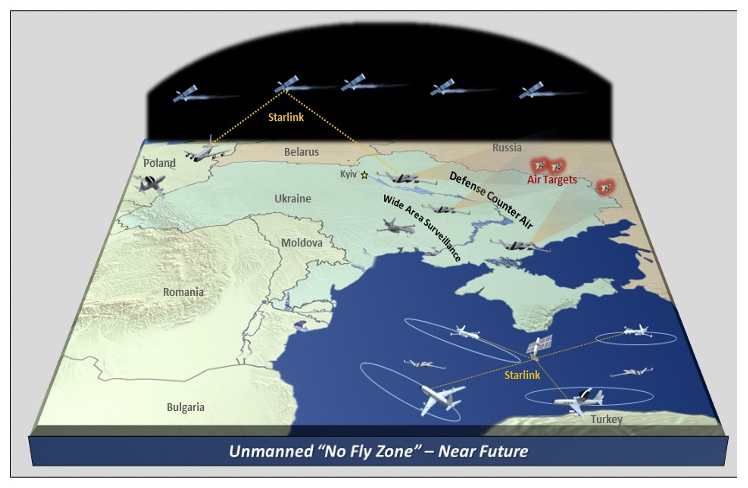
The current idea for Loyal Wingman envisions a low-observable drone with a lot of autonomy that is only reliant on a human pilot controlling several Loyal Wingman for simple commands like “follow me” or “scan this sector for airborne targets.” Since a Loyal Wingman only needs a few commands, it can use jam-proof short-range links like the F-35’s Multifunction Advanced Data Link (MADL) to communicate with its human pilot. Boeing and the Royal Australian Air Force have already developed a Loyal Wingman prototype called the Advanced Tactical System (ATS). Northrop Grumman, Lockheed Martin, and Kratos are also working on conceptual Loyal Wingman. The Secretary of the Air Force strongly supports the Loyal Wingman concept, and his pressure may lead to an operational system within 5 years.
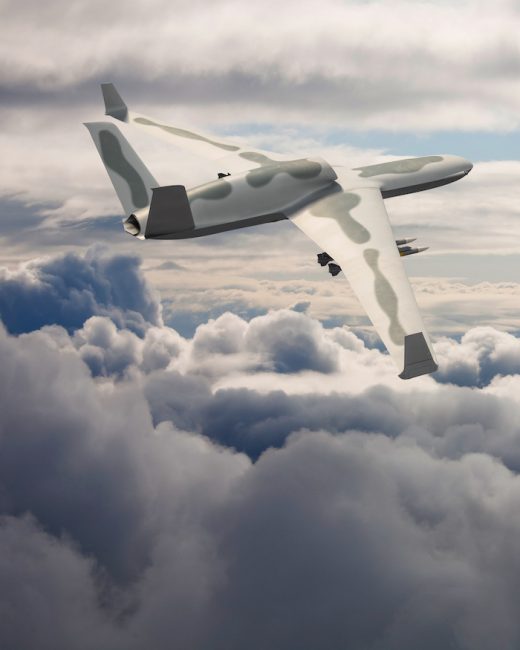
In the near future, the Defender concept may find and engage targets, only asking for engagement authorization from a human. Image courtesy of General Atomics.
General Atomics is also working on a Loyal Wingman concept, but with a twist. Instead of a human pilot flying in enemy airspace controlling a flight of drones with limited autonomy, GA’s concept involves almost completely autonomous low observable drones flying air-to-air missions in enemy airspace with human controllers merely authorizing the drones to attack vice controlling their every move. Defenders have hybrid-electric engines, allowing them to stay aloft for a month at a time and a new long wave radar that can track even stealth aircraft. Like the previous concept, GA’s “Defender” drones just need short, infrequent communication with human controllers. Unlike the other concept, GA relies on low earth orbit satellite communications (LEO SATCOM) like the SpaceX Starlink system to authorize Defender engagements from anywhere on earth.
Both concepts could work to reduce risk to the human crew, but only the Defender concept offers an entirely unmanned no-fly zone option to future coalition commanders. Systems like the Boeing ATS could fly further inside enemy airspace than their control aircraft to reduce risk to their human crews, but they must stay within the radio line of sight of manned fighters. GA’s Defender relies on LEO SATCOM to keep human crews far outside danger and I strongly suggest the Air Force add LEO SATCOM control to all autonomous drones as an option.
The USAF is also working on low-cost attritable drones. Attritable drones would support Loyal Wingman for tasks requiring prolonged exposure to enemy air defenses. Some attritable drones would supplant podded MQ-9s as outriggers for AWACS and RIVET JOINT. Some would jam enemy radars and some would merely be communications relays. Again, the idea is to either keep manned aircraft like AWACS far outside enemy defenses or use LEO SATCOM for remote drone control anywhere. Fingers crossed the Air Force can make drones cheap enough to be attritable but capable enough to be useful.
None of these concepts directly addresses suppression of enemy air defenses (SEAD) but developing a robust SEAD mission to neutralize enemy SAMs is possible. Attritable outrigger drones could easily geolocate enemy SAM radars to alert autonomous armed drones. F-35s already have all the sensors needed to guide Loyal Wingmen to fire HARMs at enemy SAM radars. Some of GA’s Defender drones could carry radar detection sensors vice air-to-air sensors to guide HARMs to their targets. Alternately, both aircraft could launch Air Launched Effects (ALEs) loitering munitions equipped with radar detecting sensors home on enemy radars as soon as they energize.
We’re Not There…Yet
True, the US is not quite there yet and cannot enforce a no-fly zone completely with unmanned assets today. The USAF is working towards a drone fleet that can accomplish the missions needed to enforce a no-fly zone without exposing aircrew to enemy defenses, but as a byproduct of its drive to fight in heavily defended enemy airspace during a major war.
However, given Putin’s trouble in Ukraine, I’ll wager major wars are becoming less likely and situations short of warfare continue to be more likely. The USAF spent 11 years enforcing no-fly zones over Bosnia, Kosovo, Iraq and Libya. It is an effective, albeit dangerous, diplomatic tool that the USAF will undoubtedly employ again. An option to enforce a no-fly zone completely with unmanned systems should therefore be a goal for the USAF’s next generation of autonomous drones. The loss of aircrew in a no-fly zone would be tragic, but can you imagine the leverage opponents would get from captured American aircrew? Now is the time to set the requirements to make both an unlikely major war and an extremely likely no-fly zone much safer for American aircrew.
Maps courtesy General Atomics.



